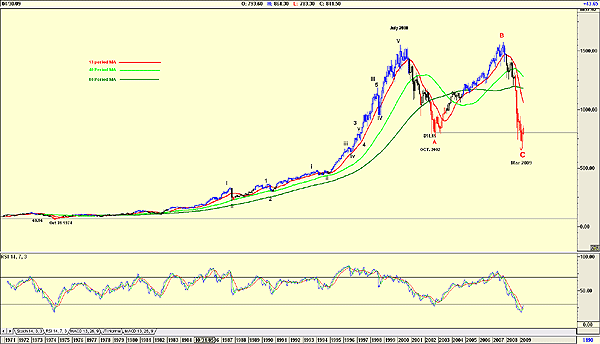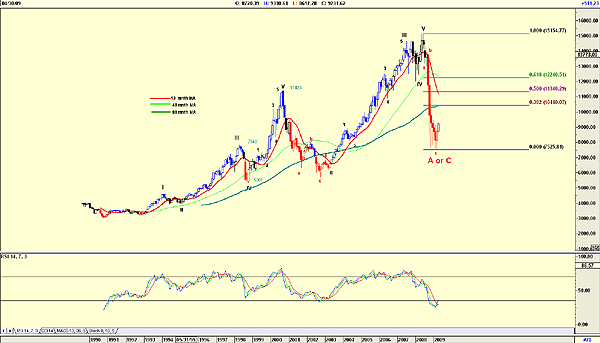
HOT TOPICS LIST
- MACD
- Fibonacci
- RSI
- Gann
- ADXR
- Stochastics
- Volume
- Triangles
- Futures
- Cycles
- Volatility
- ZIGZAG
- MESA
- Retracement
- Aroon
INDICATORS LIST
LIST OF TOPICS
PRINT THIS ARTICLE
by Koos van der Merwe
Canadian banks have taken less risk than those in the United States, and so do not need the massive bailout that US banks have received, but how are they doing?
Position: Buy
Koos van der Merwe
Has been a technical analyst since 1969, and has worked as a futures and options trader with First Financial Futures in Johannesburg, South Africa.
PRINT THIS ARTICLE
ELLIOTT WAVE
How Does The Canadian Financial System Stack Up?
04/16/09 09:51:06 AMby Koos van der Merwe
Canadian banks have taken less risk than those in the United States, and so do not need the massive bailout that US banks have received, but how are they doing?
Position: Buy
| I was taught that banks were a 3-6-3 business. The bank paid 3% interest to you when you deposited your savings and charged 6% interest when you borrowed from them, and the bank manager could be found on the golf course at 3 pm every afternoon. With regulators allowing banks to become brokers, hedge funds, and insurance agents; with their investment advisors not controlled by the same regulators as nonbank brokers; with "doctors" working behind the scenes to construct the most risky and unlikely investment structures imaginable, we should not be surprised at the recent market collapse caused by the greed of banks. And this greed has not vanished. In Canada, banks recently sold to the public rate-reset perpetual preferred shares, where buyers have no rights to force the issuer to buy back their holdings. All rights belong to the issuer, which means that lenders can only redeem their shares by selling into the market at market price... and that could be anything. So is Canada better off than the US, or are they just slower in consummating their greed? Comparing a chart of the Standard & Poor's 500 to that of the TSX 300 Index shows the difference in wave count. |

|
| FIGURE 1: S&P 500 |
| Graphic provided by: AdvancedGET. |
| |
| Note how wave B in the S&P 500 is a five-wave impulse wave in the TSX. Both started to collapse as the housing bubble burst, but the S&P 500 is in a very definite C-wave, suggesting that the bear market in the US is over, whereas with the TSX it is not clear whether it is a C-wave or and A-wave bottom. Do note that in both charts the relative strength index (RSI) has given a very definite and strong buy signal. I say "strong" because every time in the past it gave a buy signal, the market moved up strongly. Is the difference in the two charts caused by greater regulation on banks and hedge funds in Canada than in the US? There is no doubt that Canadian banks are under stricter regulation, but in Canada, banks have their own regulator, different from the regulator that monitors stockbrokers and different to those that sell only mutual funds. So the answer is, in my opinion, no. Canada's banks did not oversell mortgage-backed securities like they did in the US, but they are available and they were sold by banks to their clients. However, unlike US banks, they did not need a financial bailout, although Bank of Montreal (BMO-T) and CIBC (CM-T) came very close to needing assistance. However, as the recent rate-reset preferred shares' deal shows, Canadian banks do still put themselves first and their clients second. In the past, nonbank investment advisors were possibly just more cautious, reading the small print, or preferring to buy oil and gold than mortgage-backed securities or some bank-doctored deal that they do not fully understand. Then of course we must remember that Canada's stock market is heavily weighted toward oil, gold, and commodities, so it is possible that it was oil and gold that rescued Canada, and not "more conservative" regulations. Today, US banks are once again the "3-6-3 banks" of the past, but in Canada... they are still banks, brokers, hedge funds, and insurance agents. It is very possible that their C-wave has yet to come. |

|
| FIGURE 2: TSX 300 |
| Graphic provided by: AdvancedGET. |
| |
Has been a technical analyst since 1969, and has worked as a futures and options trader with First Financial Futures in Johannesburg, South Africa.
| Address: | 3256 West 24th Ave |
| Vancouver, BC | |
| Phone # for sales: | 6042634214 |
| E-mail address: | petroosp@gmail.com |
Click here for more information about our publications!
Comments
Date: 04/17/09Rank: 4Comment:

|

Request Information From Our Sponsors
- StockCharts.com, Inc.
- Candle Patterns
- Candlestick Charting Explained
- Intermarket Technical Analysis
- John Murphy on Chart Analysis
- John Murphy's Chart Pattern Recognition
- John Murphy's Market Message
- MurphyExplainsMarketAnalysis-Intermarket Analysis
- MurphyExplainsMarketAnalysis-Visual Analysis
- StockCharts.com
- Technical Analysis of the Financial Markets
- The Visual Investor
- VectorVest, Inc.
- Executive Premier Workshop
- One-Day Options Course
- OptionsPro
- Retirement Income Workshop
- Sure-Fire Trading Systems (VectorVest, Inc.)
- Trading as a Business Workshop
- VectorVest 7 EOD
- VectorVest 7 RealTime/IntraDay
- VectorVest AutoTester
- VectorVest Educational Services
- VectorVest OnLine
- VectorVest Options Analyzer
- VectorVest ProGraphics v6.0
- VectorVest ProTrader 7
- VectorVest RealTime Derby Tool
- VectorVest Simulator
- VectorVest Variator
- VectorVest Watchdog
